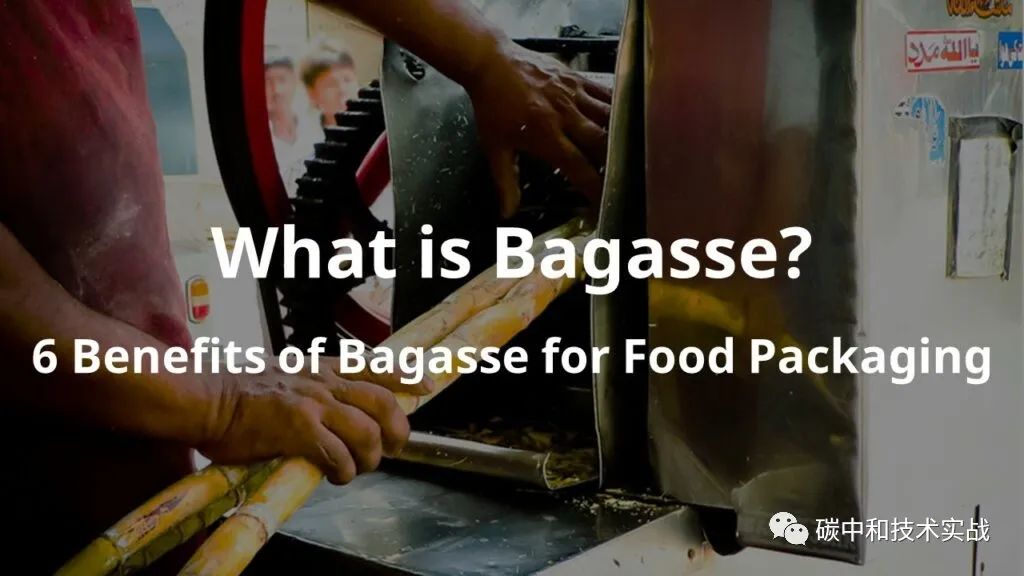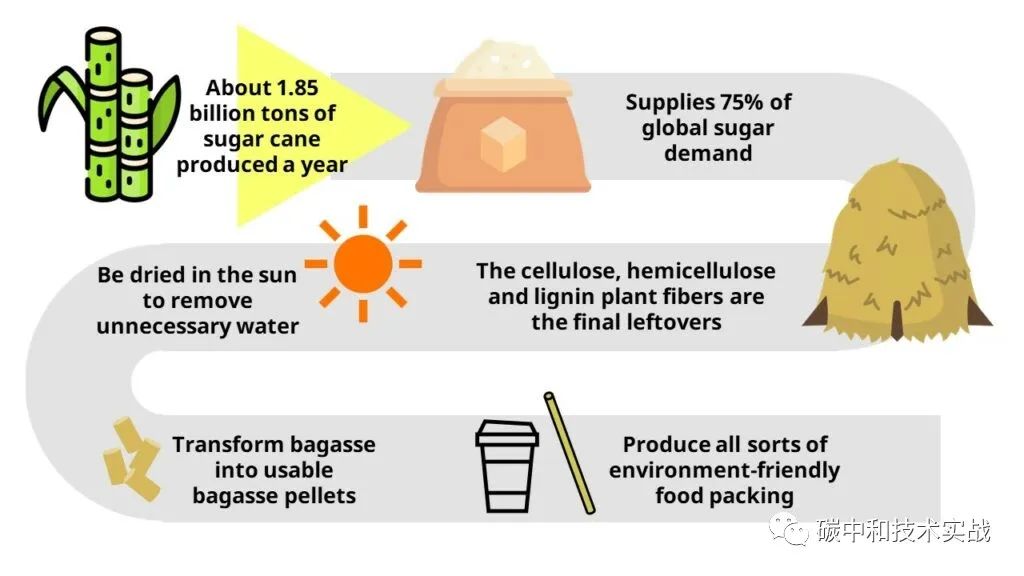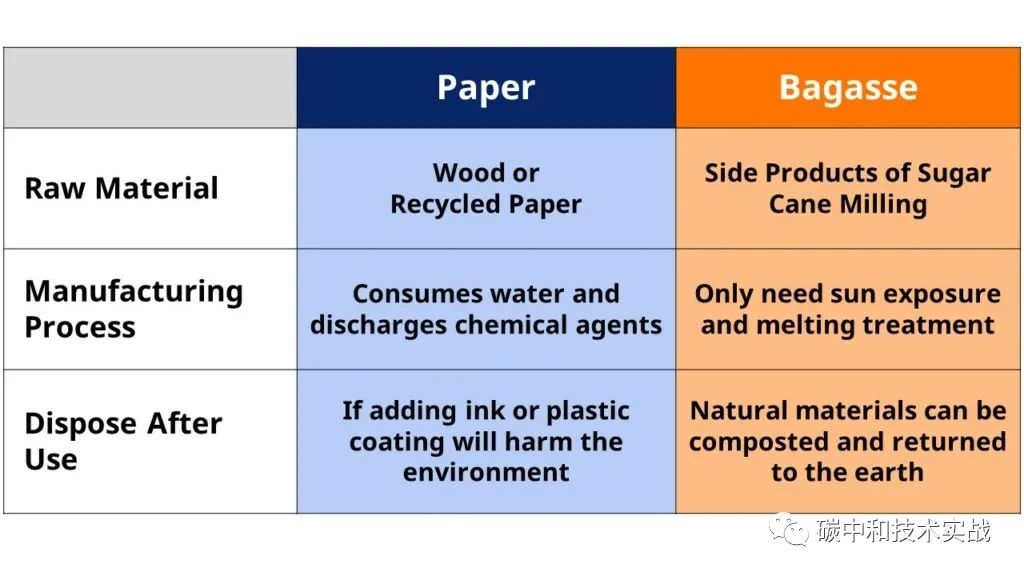Practical application of carbon neutrality technology: using sugarcane bagasse to achieve circular application and reduce carbon emissions
what is bagasse 6 benefits of bagasse for food packaging and cutlery
Sugarcane bagasse is the remaining by-product in the sugar production process using sugarcane as the raw material. It can be used as an environmentally friendly alternative to plastic and can be used in biodegradable food packaging applications to reduce the use of plastic. Sugarcane bagasse comes from agricultural waste and has advantages such as good renewability and low carbon emissions, making it a rising star in environmental protection materials. This article will elaborate on the characteristics of sugarcane bagasse and how it can be used as an environmentally friendly material.
Sugarcane is squeezed into sugar. Sugar that cannot crystallize forms molasses for the production of ethanol, while cellulose, hemicellulose, and lignin plant fibers are the final leftovers, called sugarcane bagasse.
Sugar cane is one of the most prolific crops in the world. According to World Bank statistics, the global sugarcane production in 2021 reached 1.85 billion tons, with a production cycle as short as 12-18 months. Therefore, a large amount of sugarcane bagasse is produced, which has great potential for application.
The sugarcane bagasse produced by squeezing sugarcane still contains about 50% moisture, which must be dried in the sun to remove excess moisture before it can be used to make plant-based dietary sugarcane. The physical heating method is used to melt fibers and convert them into usable bagasse particles. The processing method of these sugarcane bagasse particles is similar to plastic particles, so they can be used to replace plastic in the production of various environmentally friendly food packaging.
Low carbon materials
Sugarcane bagasse is a secondary raw material in agriculture. Unlike fossil plastic products that require the extraction of raw materials and the production of basic materials through cracking, sugarcane bagasse has significantly lower greenhouse gas emissions than plastics, making it a low-carbon material.
Biodegradable and compostable
Sugarcane bagasse is a natural plant fiber that contains rich organic matter. It can be decomposed back to Earth by microorganisms within a few months, providing nutrients for the soil and completing the biomass cycle. Sugarcane bagasse does not pose a burden to the environment.
Cheaper costs
Since the 19th century, sugarcane, as a raw material for sugar production, has been widely cultivated. After more than a hundred years of variety improvement, sugarcane currently has the characteristics of drought resistance, high temperature resistance, disease and pest resistance, and can be widely planted in tropical regions. Under the fixed global demand for sugar, sugarcane bagasse, as a byproduct, can provide a stable and sufficient source of raw materials without worrying about shortages.
Alternative to disposable tableware
Sugarcane bagasse is composed of fibers and, like paper, can be polymerized and used as a substitute for disposable plastic tableware, such as straws, knives, forks, and spoons.
Sustainable packaging materials
Unlike plastics that require oil extraction and extraction, sugarcane bagasse comes from natural plants and can be continuously produced through agricultural cultivation without worrying about material depletion. In addition, sugarcane bagasse can achieve carbon cycling through plant photosynthesis and compost decomposition, which helps alleviate climate change.
Enhance brand image
Sugarcane bagasse can be used for composting and is sustainable. It comes from renewable waste and is part of sustainable operations. By applying this environmentally friendly material, companies can encourage consumers to support green consumption and enhance their brand image. Bagasse can meet the requirements of ecologically conscious customers.
Is sugarcane bagasse environmentally friendly? Sugarcane bagasse VS paper products
The raw material of paper is another application of plant fiber, which comes from wood and can only be obtained through deforestation. The pulp content of recycled paper is limited and its use is limited. The current artificial afforestation cannot meet all the needs for paper and may also lead to the destruction of biodiversity, affecting the livelihoods of local people. In contrast, sugarcane bagasse is obtained from a byproduct of sugarcane, which can grow rapidly and does not require deforestation.
In addition, a large amount of water is consumed in the papermaking process. Plastic lamination is also needed to make the paper waterproof and oil resistant, and the film can pollute the environment during post use processing. Sugarcane bagasse products are waterproof and oil resistant without the need for additional film covering, and can be used for composting after use, which is beneficial to the environment.
Why is sugarcane bagasse suitable for food packaging and tableware
Biodegradable and compostable environmental solutions
Plant based sugarcane bagasse can decompose back to Earth within a few months. It provides nutrients and is a biodegradable and compostable material.
Home compostable
The main compostable material on the market is PLA made from starch. Its ingredients include corn and wheat. However, PLA can only be rapidly decomposed in industrial compost that requires temperatures up to 58 ° C, while it takes several years to disappear at room temperature. Sugarcane bagasse can naturally decompose at room temperature (25 ± 5 ° C) in household composting, making it suitable for frequent composting.
Sustainable materials
Petrochemical raw materials are formed in the Earth’s crust through thousands of years of high temperature and pressure, and papermaking requires trees to grow for 7-10 years. Sugarcane harvesting only takes 12-18 months, and continuous production of bagasse can be achieved through agricultural cultivation. It is a sustainable material.
Cultivate green consumption
Dining boxes and tableware are daily necessities for everyone. Replacing plastic with sugarcane bagasse can help deepen the concept of green consumption in daily life, reducing waste and greenhouse gas emissions starting from food containers.
Bagasse products: tableware, food packaging
Sugarcane bagasse straw
In 2018, a photo of a turtle with a straw inserted into its nose shocked the world, and many countries began to reduce and ban the use of disposable plastic straws. Nevertheless, considering the convenience, hygiene, and safety of straws, as well as the special needs of children and the elderly, straws are still indispensable. Bagasse can be used as a substitute for plastic materials. Compared to paper straws, sugarcane bagasse does not become soft or have an odor, is resistant to high temperatures, and is suitable for home composting. For example, renouvo bagasse straw won the 2018 Concours L é pine International Gold Award in Paris and was awarded the BSI Product Carbon Footprint Certificate and TUV OK Composite HOME Certificate.
Bagasse tableware set
In addition to replacing disposable tableware, renouvo has also increased the design thickness of sugarcane bagasse tableware and provided consumers with options for tableware cleaning and reuse. Renouvo Bagasse Cutlery has also obtained BSI Product Carbon Footprint Certificate and TUV OK Composite HOME Certificate.
Sugarcane bagasse reusable cup
The Renouvo bagasse reusable cup is designed specifically for reuse and can be used for 18 months after leaving the factory. With the unique cold and heat resistance characteristics of sugarcane bagasse, drinks can be stored within the range of 0-90 ° C according to personal habits. These cups have passed BSI product carbon footprint and TUV OK Composite HOME certification.
Bagasse bag
Sugarcane bagasse can be used to make compostable bags as an alternative to plastic. In addition to being filled with compost and buried directly in the soil, compostable bags can also be used for daily life.
Sugarcane bagasse FAQ
Will sugarcane bagasse decompose in the environment?
Sugarcane bagasse is a natural organic substance that can be decomposed by microorganisms. If properly treated as part of compost, it can provide good nutrients for agricultural production. However, the source of sugarcane bagasse must be the residue of edible grade sugarcane to avoid concerns about pesticides or heavy metals.
Can untreated sugarcane bagasse be used for composting?
Although sugarcane bagasse can be used for composting, it has a high fiber content, is easy to ferment, consumes nitrogen in the soil, and affects the growth of crops. Bagasse must be composted in specific facilities before it can be used as compost for crops. Due to the astonishing production of sugarcane, most of it cannot be treated and can only be disposed of in landfills or incinerators.
How to achieve circular economy using sugarcane bagasse?
After processing sugarcane bagasse into granular raw materials, it can be used to produce various products such as straws, tableware, cups, cup lids, stirring rods, toothbrushes, etc. If non natural dyes and other chemicals are not added, most of these products can be biodegradable and decomposed back into the environment after use, providing new nutrients for the soil, promoting the continuous cultivation of sugarcane to produce bagasse, and achieving a circular economy.
Disscuss more with William : williamchan@yitolibrary.com
Post time: Oct-05-2023



